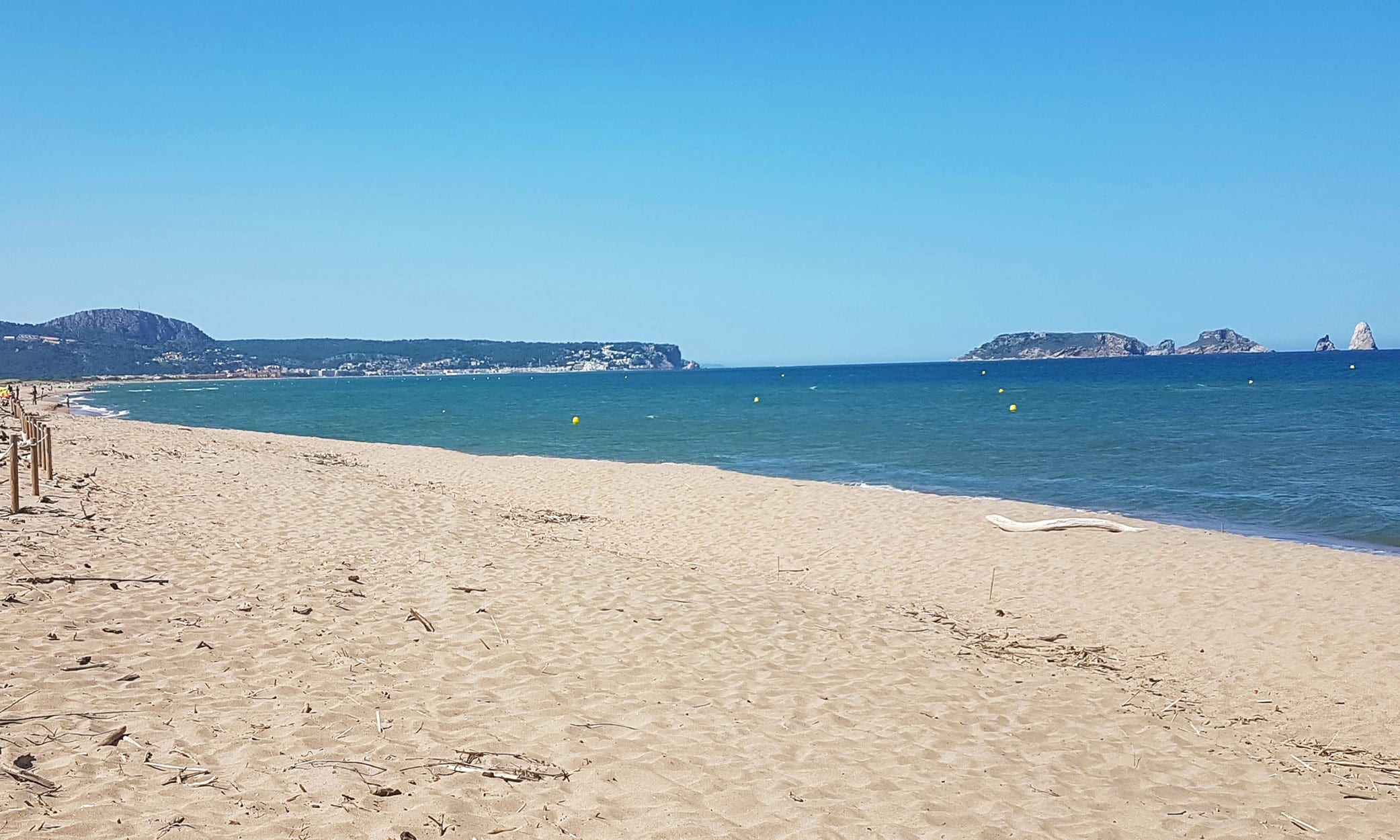We started off by trying to name our Top 10 Costa Brava beaches, but with so many stunning platjas along the coastline, we decided to focus just on the Baix Empordà coast for this article. El Baix Empordà stretches from just south of L’Escala to just below Sant Feliu de Guíxols. We’ve also included a small part of the La Selva comarca, where the Costa Brava ends and the Costa del Maresme begins.
Because trying to rank Costa Brava beaches in order starting with ‘the best’ would be so completely subjective, we’ve listed them instead from north to south. You can make your own mind up as to which is “best”, but they’re all good! Platja is the Catalan word for beach, and we’ll be using the names of the beaches as they are known here in their own language, as that’s the easiest way for you to find them on Google Maps. (Platja = playa in Castellano Spanish, by the way.)

Platja de Pals to Platja de L’illa Roja
We’re going to begin by cheating already with Platja de L’illa Roja: the “Beach of the Red Island”, located about 4km north of the town of Begur. When we say “cheating”, we mean why settle for one beach when you can enjoy three, or even four, for the price of one?
Heading south along the coast from the town of L’Estartit, you hit the beach almost immediately, and it’s pretty much a non-stop beach for over 8km until Platja de L’illa Roja. The beach changes its name a number of times on its way south, so, officially, it’s not just one beach but rather several “platjas”, but it’s really uninterrupted the whole way down, except for La Gola de Ter (mouth of the River Ter) and a couple of small creeks that can be easily paddled across.
We think the best part of the beach is the southernmost part, where Platja de Pals becomes Platja del Racó, crossing the “border” from Pals and entering the municipality of Begur. From here, you can walk a very short section of the Camino de Ronda coastal trail that takes you to Platja de L’illa Roja, so named for the reddish rocky islet that sits right in the middle of this lovely little cove. (L’illa Roja = Red Island) It is a particular favourite beach for naturists but is also popular with families.
A xiringuito was given permission to set up here during the summer of 2021, but its license was revoked almost immediately for not complying with regulations, and for a while, the “Beach of the Red Island” reverted to its natural state – in more ways than one! Despite its small size, it is one of the most popular Costa Brava nudist beaches, and because of its beauty, it has also become increasingly popular with non-nudists, leading to some friction and a campaign to preserve it for those who wish to practice naturism.
At the other end of the Illa Roja cove, which is only about 100m long, you can pick up the Camino de Ronda again and continue on to the only slightly longer Platja Sa Riera, another little absolute gem!
If you are coming to Platja de L’illa Roja by car, you can park at Platja del Racó (where there are also a few places to eat and drink) and walk the Camino to the other coves from there. Even as a round trip, it’s easily doable, and although the path ascends and descends a bit, it is very well maintained and quite short, with just a small stretch involving walking on the beach. Taken all together, this makes for a great day out. (We think it was worth “cheating” a little here! Right?)


Platja de Tamariu
This sandy beach in the picturesque seaside village of Tamariu is extremely popular during the summer season. The beach itself is pretty short at only around 200m in length, but you couldn’t ask for a more naturally beautiful setting and with the advantage of a selection of hotels, and restaurants and bars with terraces from where you can enjoy views over the beach and cove over lunch or a couple of beers.
A five-minute drive away is the tiny but gorgeous Cala d’Aigua Xelida as an added bonus. You can also walk here along a trail that, although it isn’t the easiest, is well worth the effort – especially if you enjoy snorkeling or scuba diving in crystal-clear water!

Calella de Palafrugell
Okay, Calella de Palafrugell isn’t a beach as such but rather a seaside town that is blessed with several small beaches and coves, but that’s precisely why it made our Top 10! With its iconic old white fisherman’s house and a plethora of seafood restaurants, Calella (along with its also beautiful neighbour a short distance to the north, Llafranc) is definitely a little upmarket, and with its spectacular coastline, it’s not difficult to understand why. As in both Tamariu and Llafranc (which both also belong to the municipality of Palafrugell), the beach can be enjoyed from one of the many seaside terraces with superb views.
By the way, there is another coastal town much further south on the Costa del Maresme that is also called Calella, so be sure to type in the full name, Calella de Palafrugell, if searching on Maps because, we promise you, this Calella is way nicer!


Cala Estreta
If you’re feeling energetic, you could tackle the Camino de Ronda again, heading south from Calella de Palafrugell towards Palamós. This part of the trail takes you along the coast via some exquisitely beautiful sandy beach coves: Cala del Crit, Cala Cap del Planes, Cala Roca Bona, and finally, Cala Estreta.
It’s really one stretch of beach divided into coves (in case you missed it, Cala = cove!), but probably what makes this stretch so appealing is that there are usually relatively few people here, even in summer, as it does require a bit of effort to get here. The reward is certainly worth that effort, though, and renowned travel guide Lonely Planet thinks so too, as they named it one of their 100 Best Beaches in the world in 2024!
Oh, and there’s no need to weigh yourself down on the walk by carrying your bathing suit with you, as clothing is strictly optional here!

Platja de Castell
Continuing south along the same Camino de Ronda from Cala Estreta, you come to what just might be our favourite Costa Brava beach of all: Platja de Castell. You can drive here too, but what makes this 300m long beach so great is that it’s completely surrounded by a beautifully forested protected natural area.
Located in the municipality of Palamós, this beach was earmarked for development back in 1994, but thanks to efforts and protests by local Palamosinos, the development plans were shelved, and the beach was instead declared an “Area of National Interest” in 1996. And no wonder! At one end of the beach, you’ll find the ruins of an ancient pre-Roman Iberian settlement that was inhabited from the 6th century BCE until the 1st century AD.
If history isn’t your thing, you might like to rent a kayak instead, or maybe go snorkeling. In the summer season, the only sign of development is one xiringuito, but we would recommend that you bring your esky (that’s an ice box, for those of you who don’t speak Australian!) with your own food and drinks instead as the service tends to be very poor and unfriendly, everything is way overpriced, and it’s all served on plastic that they don’t seem to even try and recycle! It could be just because they’ve no competition on the beach, but we think they do this on purpose just to remind us all that we are not actually in Paradise!
There is a spacious car park at a walkable distance from the beach, so fill up that esky and spend the day! Although this beach is set in a beautiful natural area, its proximity to Palamós means it can get crowded at times during the high season.

Platja La Fosca
If you decided to stick on the Camino de Ronda as far as Platja de Castell, you might as well carry on a little further to La Fosca beach, still in Palamós, passing more picturesque little coves on the way, naturally! You’ll know you’re about to arrive when you see more ruins, this time of a medieval castle called Castell de Sant Esteve. The castle was built on top of the ruins of an old Roman villa, which, in turn, was possibly built over an ancient Iberian settlement that dated back to the same era as the one in Platja de Castell, although more archaeological work will be required to determine for sure if this was the case.
The castle ruins overlook the beautiful La Fosca beach, which is situated on the outskirts of the town of Palamós, making it easily accessible by car, just in case you’ve had enough of hearing about that Camino de Ronda already! There is a sandbank just offshore, meaning the water doesn’t get too deep too quickly here as it does on some other beaches, making it especially popular with families. There are also a number of casual bar-restaurants for your dining and/or imbibing pleasure.

Platja Gran de Palamós/Platja de Sant Antoni de Calonge/Platja Torre Valentina
Although it bears three names, this is really one big sandy beach with an almost 4km long promenade, stretching from the Port of Palamós to Torre Valentina in Sant Antoni de Calonge. Because of its size, it never gets really overcrowded, even at the height of the tourist season, and there is space for everyone. There are a number of xiringuitos and seafront bars and restaurants at intervals all along the length of the Passeig de Mar.
It is a beach for people of all ages and is also especially popular for windsurfing, kitesurfing, sailing, and other water sports, but with areas sectioned off for swimmers. There is assisted bathing and even a floating platform at the Palamós end (in front of the Trias Hotel) for people with mobility issues, allowing safe access to the water for all. What’s not to love?

Platja Sa Conca
A bit further south, just after Platja d’Aro and belonging to the town of S’Agaró, is one of the most beautiful beaches on the Costa Brava, Platja Sa Conca, a beach of around 400m of golden sand and clear, transparent waters, with all the services and amenities you could wish for a perfect family day at the beach, including a nearby parking lot. The beach is almost, but not quite, divided into two parts by a small islet, which further adds to its beauty and charm.

Platja de Sant Pol
Only about a 20-25 minute walk further south, along one of the easiest and most beautiful sections of the Camino de Ronda, you’ll come to the Platja de Sant Pol. You can drive here too, of course, although parking can be tricky at the height of the season. However you arrive, though, you’ll find a beautiful, almost wine-glass-shaped shallow-water bay with an approximately 500m long, golden, sandy beach with all the necessary amenities. Here you can rent a boat or a kayak or even learn to sail or windsurf, or just hang out with the family. The shallowness of the bay makes it ideal for families with kids.

Platja Gran, Tossa de Mar
We started off “cheating” a little, and we’re going to finish the same way! Tossa de Mar is not in the Baix Empordà but rather in the comarca of La Selva, but we don’t care! And, after all, it is still on La Costa Brava! Anyway, we felt we just had to include a beach that is overlooked by a medieval village perched on a hill above the bay.
The beach itself is quite wide and has a promenade with lots of restaurants along its approximately 380m length. It is made up of a mixture of sand and small pebbles, and the water gets deep fairly quickly, which makes it perfect for the many popular water sports here. There are boat trips available here too, including a glass-bottom boat excursion, which is well worth doing. The highlight, though, is the old town, which is a must-see and which caused the good people at National Geographic to name it as one of its Top 25 Beaches in the World in 2013. So you see, we just had to include it!
Our “best” Costa Brava beaches
And so, there you have our Top 10 beaches of the Baix Empordà section of La Costa Brava, plus one from La Selva. If you asked somebody else they might suggest ten different beaches, and they wouldn’t be wrong either. It all comes down to a question of taste and opinion and what one is looking for in a beach. We tried to include a little of everything; beaches for families with kids, beaches for water sports, beaches with amenities as well as those that are natural, including beaches where you can strip down to your birthday suit if you like, and we even managed to take in a little history too.

Doggie beaches on La Costa Brava
By the way, if you happen to have a pooch you’ll know already that you probably won’t be able to bring him or her with you to any of the above beaches – certainly not during the summer season anyway. Just so you don’t feel completely left out, check out this link for doggie-friendly Costa Brava beaches, and also this interactive map. There isn’t a huge number of them, but at least there are some, and a couple of them just happen to be are very nice too!









